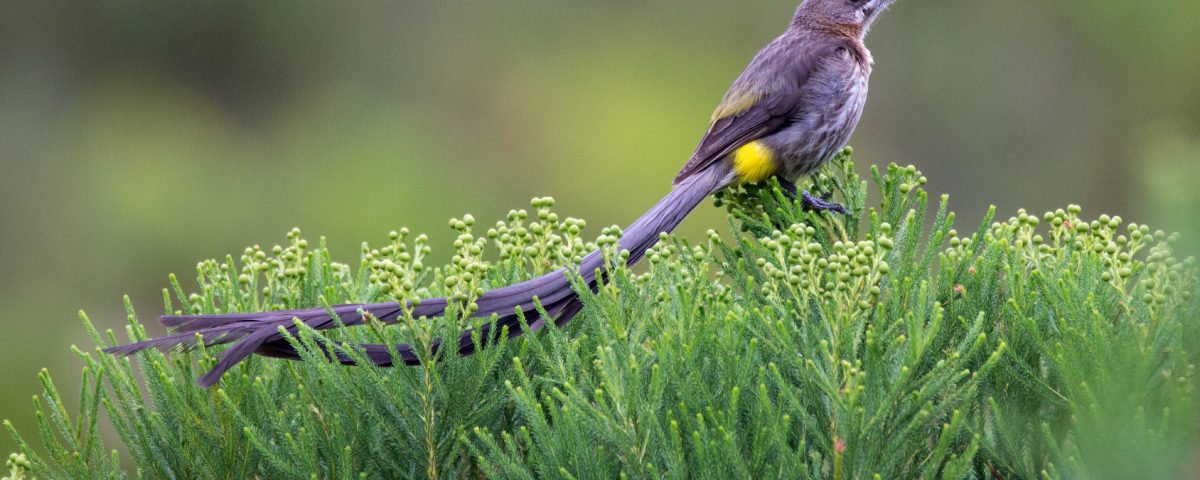
South Africa is famed for its natural beauty, not only providing breath-taking scenery, but also a rich diversity of plant and animal life. The Cape – Winelands region in the Western Cape of South Africa is no exception and contains plant and animal life that will be appreciated by walkers passing through this scenic area. Located within the Cape Floral region, the diversity of plant life in this area is huge, with the highest non-tropical concentration of higher plant species in the world. Much of this consists of Fynbos, a type of shrub land adapted to the Mediterranean climate. A high proportion of this is unique to the region. Bird and animal life is also plentiful and you might expect to see Sunbirds, eagles, hares, mongooses, genets and chameleons along the way, below are some more detailed descriptions on examples of wildlife in the area.
– The males have a bright green head and throat, with a bright orange lower breast and violet upper breast. The tail is long and black. The females have olive-yellow underparts and olive-green upperparts. A common breeder throughout the region, it tends to move to slightly higher altitudes during the summer.
– One of the largest eagles in the world, 30-38 inches long and with a wingspan of 5ft 11 to 7ft. Both Males and females are jet black in colour with bright yellow eye rings, eyebrows and ceres. Most likely to be seen in the Helderberg Nature Reserve and the Jonkershoek Valley area. Can be seen all year round.
– A species of bird endemic to the unique Fynbos biome of the Western Cape. Grey-brown in colour with a spot of yellow under its tail. Males are conspicuous by their long tail feathers and longer curved bills. Females are paler breasted and have both shorter tails and beaks. They are common throughout the general area.
– Endemic to Southern Africa, this small mammal is typically dark grey in colour with a dark tip on its tail. They are common in the fynbos habitat and even live on the fringes of suburbia. Being active during the day, it might be possible to spot them but they are generally shy and seldom seen.
– The largest predator in this area, easily recognisable by its muscular build and spotted/rosetted yellowish brown to golden coat. They are typically 90-190cm in length. It is an extremely shy animal and unlikely to be seen. However, its spoor can sometimes be seen on hiking trails after rain. Areas it might be spotted are the Jonkershoek and Assegaaibosch Nature reserves.
– Is one of the largest of all monkeys, males can be 50-115cm in length with females considerable smaller. They are a dark brown colour with black feet. The baboons have populations in Helderberg, Jonkershoek and Assegaaibosch Nature Reserves but they are more likely to be heard than seen.
– A small species of antelope, reaching 43-60 cm at the shoulder. The coat is coarse and of a yellowish gray to reddish brown colour. There are populations throughout the Western Cape region although they prefer rocky terrain with sparse vegetation such as that of the Jonkershoek Mountains. They may be seen at lower levels if food becomes scarce although they are only mainly active in the early morning or late afternoon.
– The most widespread snake in Africa, they are worth a mention as they are one of the leading causes of venomous snake bites on the continent. Easily identified by the distinctive V-shaped patterns along their back. Their colour varies from a dull grey to light brown, yellow, or even red, and they have a large, triangular, and heavily keeled head. A pale stripe runs along the top of the head, between or behind the eyes. Unlike most snakes, they freeze on approach and are often stepped on. Most likely to be found on rocky outcrops in forest or grassland
– Another venomous snake, its name translates as Tree Snake from Afrikaans and Dutch, a reference to its arboreal nature. They average 160cm in length with the females olive-green and males light green with black scales on their back. They are not aggressive and tend to bite only when cornered or confronted. Almost exclusively arboreal, they may be spotted in trees and bushes. Most likely to be seen in the Helderberg reserve or the Jonkershoek/ Assegaaibosch reserves.
– Native to the Western cape region, adults can vary substantially in appearance, with different colours, patterns and saturation of colour dependent on the terrain they live in. They average about 2.5 to 3 inches in length. Found throughout the region, concentrations are likely to be higher in the nature reserves. They are more likely to be seen on warmer sunny days when they like to absorb heat.
Sign up to receive the latest information on World Walks